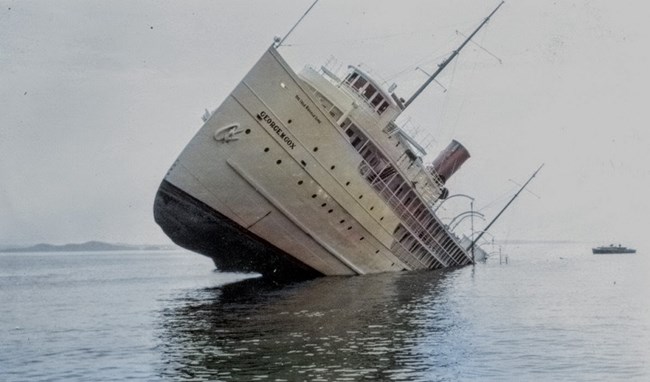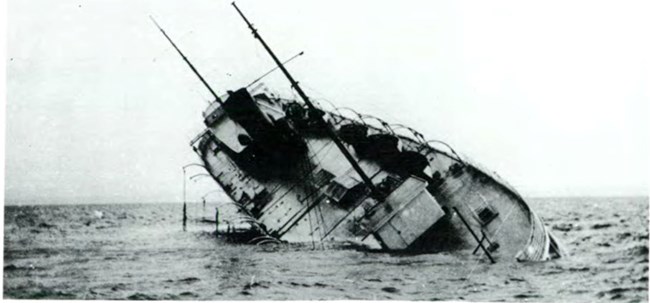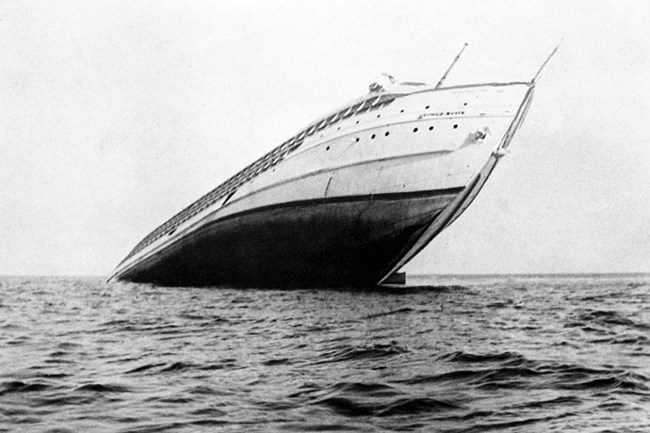Last updated: September 21, 2020
Article
SS George M. Cox: Wreck Event and Survivor Accounts

Larsen Collection
Wreck Event
The first voyage of Puritan as the newly appointed George M. Cox was also to be its last. On May 25, 1933 the ship left Chicago bound for Port Arthur to begin its new route in the passenger trade between those two cities. Intermediate stops were planned for Houghton and Isle Royale.
The steamer left Saturday May 27, from Marquette at 2:00 a.m. bound for Houghton with namesake George M. Cox and 124 others aboard (Daily Mining Gazette, May 27, 1933). The captain was George Johnson of Traverse City and the first mate was Arthur Cronk. There was also an eight-piece orchestra aboard ready to join in the festivities anticipated on the maiden voyage (Manistee News Advocate, May 24, 1933).
Cox arrived in Houghton and tied up at the Peninsula dock around noon after its ten hour run. The vessel was opened for inspection and hundreds of local residents toured the finely appointed cruise ship (Daily Mining Gazette, May 28, 1933).
George M. Cox left Saturday afternoon, May 27, 1933, for Isle Royale, but Cox ran hard aground off the west end of Isle Royale sometime before 6:00 p.m. Saturday evening while those on board ate dinner. The steamer Morris S. Tremaine intercepted a wireless SOS message from the stricken ship, and the first word reached Houghton about 8:00 p.m. Word of the disaster was received by Capt. Fred Sollman of the Portage Canal Coast Guard via Ft. William. The Coast Guard left immediately for the wreck site (Daily Mining Gazette, May 28, 1933).

Lake Superior Marine Museum
Five life boats were lowered on the port side; the boats on the starboard side were not launched because of the extreme port list. The passengers were loaded into the ship's lifeboats and towed to Rock of Ages by lightkeeper John Soldenski's motor launch. The passengers took turns warming themselves in the limited quarters of the lighthouse, and they were served hot coffee by the wife of the lightkeeper (Cleveland News, May 29, 1933).
The operational procedures of the U.S. Coast Guard at Portage Canal Station and aboard the cutter Crawford offer some insight into the Cox rescue operations. About 8:00 p.m. the Portage Station received the following telegram, from Port Arthur: "Steamer George M. Cox aground on Rock of Ages. In bad shape. Want assistance." ("Letter from F.C. Sollman, Officer in Charge, Portage Station to John Hanson, Bureau of Navigation and Steam boat Inspection," June 7, 1933). Within 10 minutes a lifeboat and crew left the station. The Portage crew arrived at the wreck site at 2:15 a.m. the morning of the 28th. All passengers and crew had been removed from the wreck and were safe on Rock of Ages.
-
Stanley Sivertson: Wreck of the America
Oral History 61: Stanley Sivertson 3 & 4
- Credit / Author:
- Dave Snyder: ISRO Archives.
- Date created:
- 03/03/1987

Isle Royale National Park Archives
The Portage crew transported 43 persons from the lighthouse to Washington Island hotel dock on Isle Royale and returned to Rock of Ages. Captain Johnson requested the removal of baggage from the wreck, and 71 bags, suitcases and other baggage items were taken aboard the lifeboat and transported to the lighthouse, arriving there at 8:40. Twenty crew members were transported from the lighthouse to Crawford with some of the baggage, then 12 more of the Cox crew were transported to Washington Harbor.
Crawford arrived on site at 5:35 a.m., May 28, and anchored in 3 fathoms of water. Five minutes later the officer of the North Superior Coast Guard was aboard to brief the officers of Crawford. Captain Johnson was consulted on the disposition of the passengers and crew. Johnson responded that he wanted them taken to Houghton, Michigan. The Cox crew and passengers were loaded aboard, and the cutter proceeded to Washington Harbor to pick up the people who had been transferred there. The Coast Guard lifeboat from Grand Marais had engine trouble and was towed to the Singer Dock in Washington Harbor by Crawford. The ship encountered dense fog on the way to the dock, finally arriving at 8:55 a.m. In an hour, all remaining people were loaded and Crawford was underway to Houghton. The total aboard was recorded in the Crawford log as 113 ("Log of the U.S. Coast Guard Patrol Boat Crawford," May 27, 28, 1933).
Media Coverage / Survivor Accounts
Four persons were injured, one seriously, in the wreck, the first on the Great Lakes this season, but no lives were lost. The four, with George M. Cox of New Orleans ... and a nurse were brought to Fort Williams by the freighter M.S. TREMAINE and placed in a hospital
Mrs. Cox said Sunday afternoon that she talked with her husband Sunday morning at Port Arthur, Canada, by long distance telephone and that he suffered no ill effects from his harrowing experience.
The GEORGE M. COX, making her first trip of the season, was en route to Port Arthur, Ont., from Chicago to pick up 250 Canadian residents and take them to the Century of Progress Exposition at the latter city. Thirty-two of the persons aboard on the out bound trip were passengers ....
Plowing through a heavy fog, the steamer, with its passengers at dinner, struck an extended ledge of rock a short distance from Rock of Ages Lighthouse with such force that her engines and boilers were ripped loose. The impact threw the passengers to the salon floors and sent tables and chairs crashing against the walls.
Keepers of the Rock of Ages Light said they saw the spars of the steamer above the low-hanging fog and made frantic but futile efforts to attract the' vessel's attention with the siren. A few minutes after the vessel struck she had broken open and filled with water until her top decks were awash.
Only the, fact that the Lake was calm enabled the keepers of the light and the crew of the steamer to transfer everyone to small boats and rafts and avoid loss of life.
